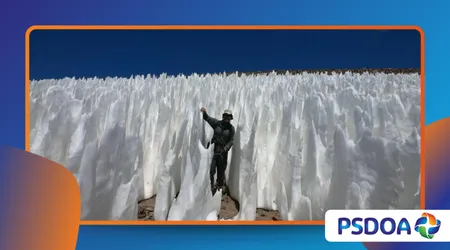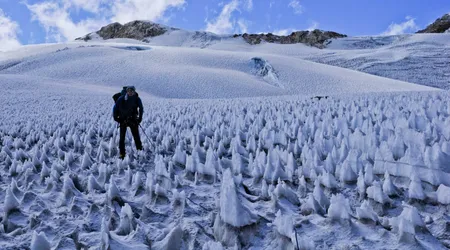Penitentes: Púas de hielo con forma de cuchilla que se encuentran en regiones de gran altitud

Las espectaculares formaciones de hielo conocidas como Penitentes Se encuentran entre las obras maestras escultóricas más fascinantes de la naturaleza, aunque menos comprendidas.
Anuncios
Estas imponentes cuchillas de nieve y hielo, lo suficientemente afiladas como para cortar, transforman los campos de nieve de gran altitud en paisajes surrealistas que se asemejan a campos de figuras encapuchadas y arrodilladas.
Este fenómeno único es principalmente un espectáculo de los Andes Secos, pero extiende su alcance a otras regiones de baja latitud y gran altitud en todo el mundo.
El proceso de formación es un ejemplo perfecto de cómo fenómenos físicos sutiles pueden dar lugar a características geológicas espectaculares.
Comprensión Penitentes No se trata simplemente de un ejercicio académico; es crucial para los glaciólogos y climatólogos que estudian los recursos hídricos.
Anuncios
Estas formaciones de hielo influyen significativamente en el balance energético de los glaciares, afectando las tasas de fusión y, en consecuencia, el suministro local de agua.
¿Por qué y dónde se forman los Penitentes?
Penitentes Para que se den estas condiciones, se requiere una combinación muy específica de condiciones atmosféricas y solares. Los ingredientes clave son aire extremadamente seco, radiación solar alta y sostenida, y temperaturas que se mantienen bajo cero la mayor parte del tiempo.
Estas condiciones impiden la fusión, favoreciendo un proceso llamado sublimación.
Suelen encontrarse en los Andes tropicales y subtropicales, particularmente por encima de los 4.000 metros, aunque pueden aparecer dentro de los 55° del ecuador.
La baja humedad necesaria implica que el aire contiene muy poco vapor de agua, lo que permite que el hielo pase directamente a gas sin llegar a licuarse. Este proceso crea los característicos bordes afilados del hielo.
++ Rodillos de nieve: bolas de nieve auto-rodantes formadas por el viento
¿Qué es la sublimación y cómo impulsa el crecimiento?
La sublimación es el cambio de fase directo del hielo sólido al vapor de agua, sin pasar por la fase líquida. En las profundas depresiones de la superficie de la nieve, la radiación solar se concentra y se absorbe.
Este calor localizado provoca una sublimación más rápida en los valles que en los picos.
Las pequeñas hendiduras aleatorias iniciales en la nieve se magnifican convirtiéndose en depresiones debido a que la luz solar reflejada provoca una mayor ablación en esas zonas que en los puntos más altos.
Esta inestabilidad autoamplificada, donde las depresiones se profundizan más rápidamente, es el mecanismo fundamental que genera el terreno irregular.
Lea también: Cascadas de arena: movimiento de arena similar a una cascada en desiertos y cuevas
¿Cómo determina la posición del Sol la estructura?
La geometría y orientación de Penitentes son resultado directo del recorrido del sol a través del cielo.
Sus crestas y valles se alinean en dirección este-oeste, y las imponentes aspas se inclinan hacia el sol al mediodía local. Esta alineación maximiza la absorción de la radiación solar en las laderas.
Este crecimiento impulsado por la energía solar pone de relieve la notable relación entre la energía radiante y la morfología del hielo en entornos áridos de gran altitud.
Incluso cambios sutiles en el ángulo del sol o la nubosidad pueden alterar la velocidad y la dirección de su crecimiento vertical. El más alto registrado Penitentes han alcanzado alturas de más de cinco metros.

¿Por qué son importantes los penitentes para la ciencia y el clima?
Las estructuras dramáticas de Penitentes Son más que un espectáculo hermoso y poco común; contienen datos cruciales para comprender la glaciología y los impactos del cambio climático.
Su presencia modifica drásticamente el albedo, o reflectividad, de la superficie de la nieve.
Un campo de nieve prístino y plano refleja la mayor parte de la luz solar, pero las superficies irregulares y sombreadas de Penitentes absorber mucha más radiación.
Esta disminución de la reflectividad altera el balance energético local del glaciar, aumentando las tasas de fusión y acelerando la pérdida de masa glaciar.
Leer más: Fulguritas: Vidrio formado por rayos oculto bajo tierra
¿Cuál es el significado analógico de su estructura?
Considerar Penitentes como una vasta y natural serie de diminutos colectores solares incrustados en la nieve. Mientras que una superficie plana y blanca (nieve fresca) actúa como un simple espejo, las agujas (Penitentes) actúan como trampas de calor.
Las sombras que proyectan absorben el calor, y las depresiones cóncavas lo reflejan y lo concentran internamente.
Esta compleja interacción acelera la ablación mucho más allá de lo que experimentaría una superficie de nieve uniforme.
La investigación sobre su formación se lleva a cabo activamente en laboratorios, utilizando entornos controlados para generar “micro-penitentes” de apenas unos centímetros de altura para modelar estos procesos en tiempo real.
¿Por qué son un indicador clave de las condiciones planetarias?
Se ha teorizado sobre la formación de picos de hielo similares y, en algunos casos, se ha identificado tentativamente en otros cuerpos planetarios, como Plutón.
Esto hace que Penitentes Un análogo terrestre vital para los procesos criogeológicos en lunas heladas y planetas enanos de nuestro sistema solar.
Estos extraterrestres PenitentesEstas capas, probablemente compuestas de hielo de metano o nitrógeno en lugar de hielo de agua, pueden alcanzar cientos de metros de altura, lo que refleja las condiciones atmosféricas y térmicas únicas de mundos distantes.
El estudio de la física de su formación en la Tierra ayuda a los científicos a comprender la evolución de las superficies en todo el cosmos.
¿Cómo impactan los Penitentes en las regiones de gran altitud?
La presencia de un Penitentes El terreno crea condiciones difíciles y a menudo peligrosas para el tránsito humano y la ecología local.
Para los montañeros, atravesar estas densas y altas formaciones es extremadamente difícil y lento, y a menudo requiere una navegación cuidadosa entre las frágiles láminas de hielo.
Los ecosistemas locales también se ven afectados. Estudios recientes lo han confirmado. Penitentes Puede albergar una vida microbiana única, incluidas algas de nieve especializadas.
Estos microbios viven en el hielo y contribuyen a la apariencia oscura de la superficie, lo que podría acelerar aún más la tasa de fusión al reducir el albedo.
¿Cuáles son los peligros para viajeros y montañeros?
Atravesando un campo de altos Penitentes Es como intentar recorrer un laberinto denso y escarpado con los ojos vendados. Las agujas varían en tamaño desde unos pocos centímetros hasta cinco metros, lo que convierte el paso en una sucesión continua de escalones que suben y bajan por pendientes pronunciadas.
Este terreno es físicamente agotador y conlleva un riesgo significativo de lesiones por caídas o pinchazos.
El gran explorador Charles Darwin documentó la dificultad de cruzar campos de nieve cubiertos de nieve. Penitentes cerca del paso de Piuquenes en los Andes centrales durante su viaje de 1835.
Sus observaciones constituyeron algunos de los primeros registros científicos del fenómeno, poniendo de relieve el desafío histórico que plantean estas formaciones.
¿Qué nos dice la investigación actual sobre los penitentes?
Actualmente se utilizan técnicas avanzadas de monitoreo, incluido el escaneo láser (LiDAR), para rastrear la evolución tridimensional de estos campos de hielo durante una temporada de ablación.
Estos datos proporcionan mediciones precisas de crecimiento y decadencia, ofreciendo información sin precedentes sobre su física subyacente.
Un estudio significativo de 2024 reveló que el rango de temperatura mínimo para Penitentes La formación en un entorno de laboratorio se sitúa entre $-10^\circ \text{C}$ y $-5^\circ \text{C}$, lo que refuerza el papel crítico de condiciones frías específicas, pero no demasiado frías.
Este detalle ayuda a delimitar con precisión su distribución geográfica y altitudinal en la Tierra y más allá.
| Penitentes – Características clave | Medida/Descripción | Significado |
| Rango de altura típico | $1 \text{ a } 5$ metros (terrestre) | Peligro para el montañismo e indicador visible de ablación. |
| Mecanismo de formación | Sublimación (Hielo directamente a vapor) | Requiere baja humedad y radiación solar intensa. |
| Ubicación principal | Andes secos (subtropicales, de gran altitud) | Área de estudio de recursos hídricos críticos. |
| Orientación | Alineado de este a oeste, inclinado hacia el sol | Demuestra que la radiación solar es el principal factor determinante de su geometría. |
| Impacto en el albedo | reflectividad significativamente reducida | Acelera la pérdida de masa glacial y el calentamiento local. |
Fuente: Compilado a partir de múltiples estudios de glaciología y criosfera (2015-2025).
Las agujas dentadas que se alzaban hacia el cielo de Penitentes Son un testimonio impresionante del poder de la radiación solar actuando sobre el hielo en ausencia de humedad.
La ciencia detrás Penitentes continúa evolucionando, revelando su profundo impacto en la glaciología, el clima e incluso la ciencia planetaria.
Son un poderoso y silencioso indicador del delicado equilibrio entre el sol, la nieve y la atmósfera. ¿Sabías que estas majestuosas formaciones de hielo se rigen por una física tan precisa y sutil?
¡Comparte tus reflexiones y experiencias sobre fenómenos naturales raros en los comentarios a continuación!
Preguntas frecuentes
¿Los penitentes solo se encuentran en los Andes?
No. Si bien los Andes, en particular los sectores argentino y chileno, son el lugar más famoso por sus grandes y bien desarrolladas PenitentesTambién se han observado en otras regiones de gran altitud y baja latitud con condiciones climáticas similares, como el Himalaya.
¿Cuál es la diferencia entre Penitentes y Suncups?
Penitentes Son agujas altas, afiladas y con forma de hoja, formadas principalmente por sublimación en condiciones frías y secas sin fusión superficial.
Las copas solares son depresiones redondeadas y menos profundas, que se forman típicamente en condiciones menos secas donde se produce cierta fusión superficial en los huecos.
¿Puede formarse el fenómeno de Penitentes en mi patio trasero durante el invierno?
No. Penitentes requieren una combinación de humedad atmosférica extremadamente baja (baja presión de vapor), radiación solar intensa y sostenida, y rangos de temperatura específicos (lo suficientemente fríos para evitar la fusión pero lo suficientemente cálidos para impulsar la sublimación).
Estas condiciones generalmente se limitan a entornos de gran altitud.
¿Por qué se les llama “penitentes”?
El nombre proviene de la palabra española que significa “penitentes”. Los primeros observadores sintieron que las formaciones de hielo se parecían a grupos de figuras encapuchadas y arrodilladas que se ven a menudo en las procesiones religiosas durante la Semana Santa, con altos sombreros cónicos.
